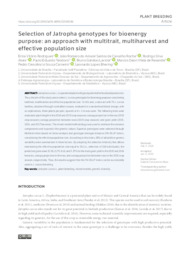Selection of Jatropha genotypes for bioenergy purpose: an approach with multitrait, multiharvest and effective population size.
Selection of Jatropha genotypes for bioenergy purpose: an approach with multitrait, multiharvest and effective population size.
Author(s): RODRIGUES, E. V.; ROCHA, J. R. do A. S. de C.; ALVES, R. S.; TEODORO, P. E.; LAVIOLA, B. G.; RESENDE, M. D. V. de; CARNEIRO, P. C. S.; BHERING, L. L.
Summary: Jatropha curcas L. is a perennial plant with great potential for biodiesel production. Thus, the aim of this study was to select J. curcas genotypes for bioenergy purpose considering multitrait, multiharvest and effective population size. To this end, a data set with 70 J. curcas families, obtained through controlled crosses, evaluated in a randomized block design, with six replications, three plants per plot, spaced at 4 × 2 m was used. The following traits were evaluated: plant height in the 2014 and 2015 crop seasons; canopy projection in the row (2015 crop season); canopy projection between rows (2015 crop season); and grain yield (2015, 2016, and 2017 harvests). The mixed model methodology was used to estimate the variance components and to predict the genetic values. Superior genotypes were selected through Multitrait index based on factor analysis and genotype-ideotype distance (FAI-BLUP index), considering the effective population size. According to this index, 98% of all additive genetic variability were summarized in three factors. By adopting the selection intensity that allows maintaining the effective population size equal to 30 (i.e., selection of 214 individuals), the predicted gains were 15.56, 21.75, 4.16, and 5.37% for the traits grain yield in the 2015 and 2016 harvests, canopy projection in the row, and canopy projection between rows in the 2015 crop season, respectively. Thus, the results suggest that the FAI-BLUP index can be successfully used in J. curcas breeding.
Publication year: 2020
Types of publication: Journal article
Unit: Embrapa Agroenergy
Observation
Some of Embrapa's publications are published as ePub files. To read them, use or download one of the following free software options to your computer or mobile device. Android: Google Play Books; IOS: iBooks; Windows and Linux: Calibre.
Access other publications
Access the Agricultural Research Database (BDPA) to consult Embrapa's full library collection and records.
Visit Embrapa Bookstore to purchase books and other publications sold by Embrapa.

